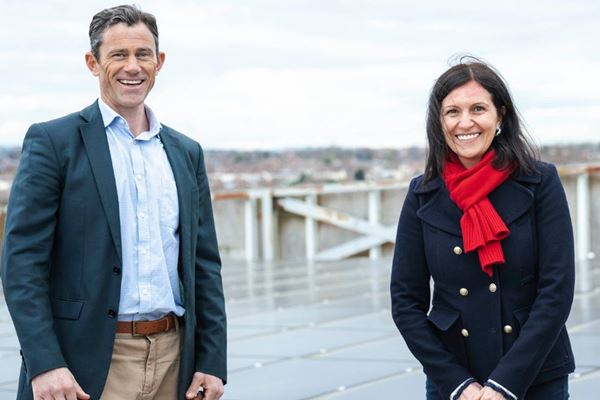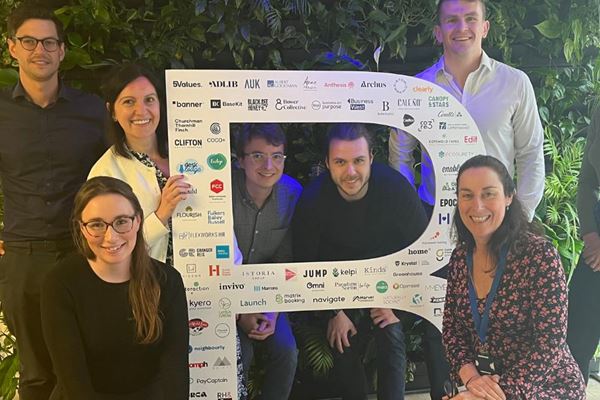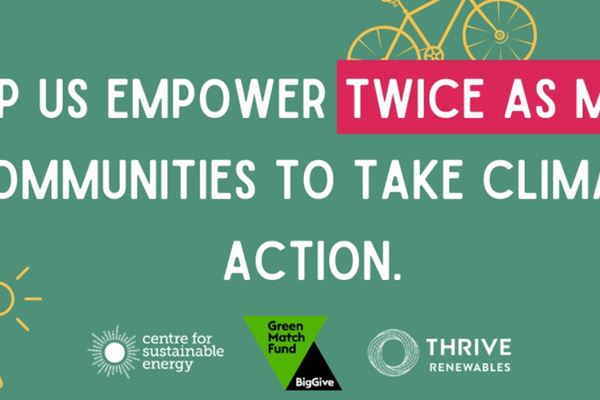Arriving in Glasgow, I remember why I look forward to attending All-Energy each year – the buzzy atmosphere, idea sharing with likeminded people and hearing about innovative projects helping to accelerate our journey to net zero. In fact, it’s where I chose to pursue renewables as a career back in 2007.
As well as exhibiting at the show, Thrive took part in several panels and presentations. My colleagues Otis (Investment Manager) and Chris (Development Manager) presented at the Community and Local Energy Show Floor Theatre, discussing Thrive’s funding offer for local energy projects – including the benefits to shared ownership and our role in the funding of England’s largest onshore wind turbine.
I also shared my thoughts on community ownership of offshore wind, following a great paper from Regen on the same topic, and moderated a panel on Power Purchase Agreements (PPAs) - an agreement which is used to sell electricity generated by clean energy projects like wind farms or solar arrays. Joined by Kristina Rabecaite, CEO of PPAYA Limited, Tom Abbott, Head of PPA at EDF (UK), Leigh Brown, Senior Business Development Manager at SmartestEnergy and Rhys Thomson, Commercial Director at Community Windpower Limited, it was great to hear their thoughts on the latest and future trends in PPA routes and how they can support renewable developers and generators in selling their power. A big thank you to the speakers who joined me and the fabulous audience for a very engaged session.
Alongside Thrive’s sessions, it was great to hear from others working within the industry and get their insights on how the market is developing. Below I share my key observations from across the two days.
1. Communities are ready to scale up and share ownership
It’s great to see an increasing number of people engaging with community energy initiatives and an appetite to take on larger size projects. Shared ownership models are mutually beneficial – allowing communities to access working capital, experience, and exposure, while developers can benefit from shared infrastructure, local support and collaboration.
At Thrive, our flexible approach to finance could help facilitate shared ownership. Our 20MW battery in Bristol is proof of this – we’re giving Bristol Energy Cooperative an opportunity to own a share in the project so that local good causes can benefit from some of the revenues.
2. Finance is changing
Until a longer-term picture emerges in terms of interest rates and inflation, many developers have shared that they are now looking for short term finance solutions, as well as one funding partner that they can work with across a portfolio of projects.
When it comes to finding a route to market, the conference confirmed that Power Purchase Agreements are also getting more complex and will increasingly involve multiple parties as they purchase different parts of a project’s offtake. We’ve also seen shorter term PPA structures emerge, while corporate PPAs are becoming increasingly attractive as they give projects more security around electricity prices.
3. Direct wire is becoming more popular
Many UK businesses are looking to on-site renewables as a solution to manage energy costs in a volatile market and to improve their environmental credentials as they work towards net zero. Many don’t necessarily have the capital – or skill set – to install those renewables themselves and therefore need support with funding and expertise. It was positive to see many businesses, developers and EPC contractors using the conference as a way to meet and take project opportunities forward.
4. Community crowdfunding for offshore wind
At Thrive, we’re big believers in community ownership and the importance of keeping the economic, social and environmental benefits of clean energy projects local. This is a topic I’m really excited about and would certainly deliver a multitude of benefits for the local community, as well as helping to facilitate a just transition in the offshore wind industry. It will be interesting to see how community ownership models for offshore wind evolve in the years to come.
5. Renewable heat is taking off!
According to the International Energy Agency (IEA), heating is the world’s largest energy end use, accounting for almost half of global final energy consumption. As the world continues to grapple with the ongoing energy crisis, the IEA also predicts that modern renewable heat consumption will increase by almost one-third between 2022-2027.
It was interesting to hear more about the future of renewable heat at the conference and the technologies, policies and track record showcased by other countries. While there are still some challenges to overcome – including the need for a clearer revenue model – it’s been suggested that some kind of grant programme will need to be developed in order to accelerate this technology at the scale required.
6. Growing green careers
Finally, it was a huge pleasure to see so many students who are looking at this industry as a future career path. We had discussions with students whose interests ranged from sustainable concrete to impact financing and digitalisation. It’s really positive to see fresh young talent entering the sector and the passion they have for making the world a better place. At Thrive, we aim to support students as much as we can and currently offer a summer internship to university undergraduates looking to understand more about the clean energy sector, whether it be in engineering, financial modelling or community benefit.







